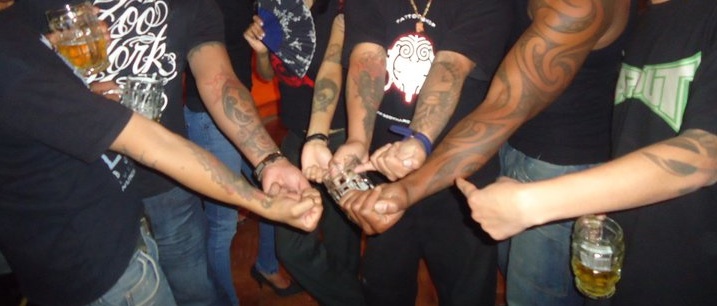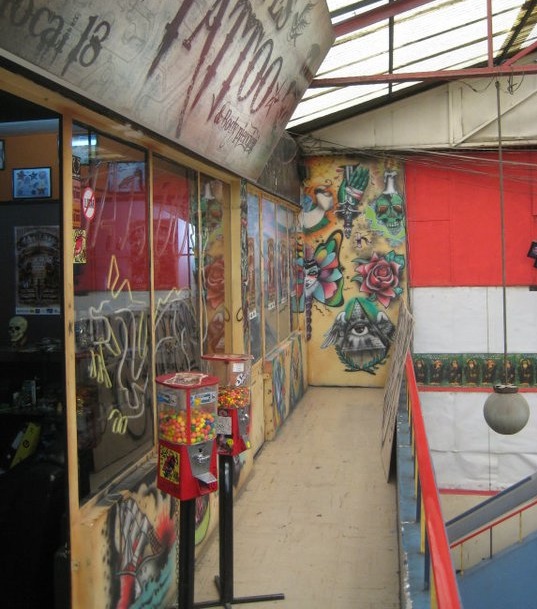I expected a very cool, reserved response, but he actually got quite excited to see me. When I touched his shoulder, he slowly turned my direction, but upon recognizing me gave a little skip-like hop in my direction and gave me a hug.
This reaction surprised me. I expected something more reserved. More cool, calm, and collected. More “oh, I’m a cool tattoo dude, and you’re some gringa I’ve met twice before so I’ll say ‘hola’ and kiss you on the cheek, but no need to dwell.” But instead I got what felt like a genuinely excited reception. And I think the reason I expected something different, lies in the corporeality I’ve come to associated with the Tito’s guys.
Primarily meaning, Alé’s embodiment. He is calm and collected. Too cool, in many ways. Quiet, but brooding. He stands calmly, as if his feet are fastened to the floor and his chest is magnetized to the sky. His shoulders are back and down, as if he could wipe his hands across his chest and it would seem natural. He is slow and sustained. And a bit strained. He pulls his head back a little. He is tired. He is bored.
Edwin, the owner of Tito’s, is slow too. The way “cuando llegaste?” pulled out of his mouth the first time we saw each other this January, made an impression on me. Like taffy. Sweet and slow. But never overly enthusiastic.
Diego, my first friend from Tito’s, is slow too, though with flourishes like Gonz, at times (though mostly out of anger). But he is heavy and tied to the ground. Diego, Edwin, & Alé all have a certain slowness. A liquidity. A gravity.
And Gonz in some ways is their opposite. He is jumpy, easily excited. He smiles wide and wags his hands. He moves his head forward when he listens. He has a weight to him. It is not as if he will float away at any moment. But one has the feeling that he could jump without warning, and land sloppily but with ease.
Perhaps one doesn’t need to theorize all this. Perhaps we all understand that the way one moves in the world says something about the person. She who walks with her head held high and a swagger in her step announces her confidence (and so much more), and we all understand. But I take time here to explain, because sometimes it is so seemingly natural that we barely notice. As Bourdieu explains: “When habitus encounters a social world of which it is the product, it finds itself ‘as fish in water’; it does not feel the weight of the water and takes the world about itself for granted” (in Wacquant 2004:43).
But as much as movement may seem natural, both the actor and the observer organize moves into meaningful action. I see the gravity and liquidity of most of the Tito’s guys and I interpret it as gestures toward “badass,” “too cool,” and “aloof.” In my head I hear Snoop Dog playing...
So then, this all begs the question…do the Tito’s guys conceive tattooing as a mental creative process or as a physical skill? Most likely it’s a combination, but what is privileged? What is heightened and what is obscured? Which is the attractive part? And what does that tell us about embodiment?
Best, David
1974 Expression in Movement and the Arts. Lepus Books, London.
Butler, Judith
1999 Gender Trouble. New York: Routledge.
Geertz, Clifford
1973 Interpretation of Cultures. New York: Basic Books.
Goffman, Erving
1959 The Presentation of Self in Everyday Life. Garden City: Prentice Hall.
Mauss, Marcel
1979 Sociology and Psychology: Essays. Ben Brewster, trans. Boston, MA: Routledge 1973 Techniques of the Body. Economy and Society 22(1):70-88.
Prost, J.H.
1996 Review Essay: Body Language in the Context of Culture. Visual Anthropology 8(2-4):337-43.
Wacquant, Loïc
2004 Body and Soul: Notebooks of an Apprentice Boxer. New York: Oxford University Press.


 RSS Feed
RSS Feed
